Exhibit 99.3

| Aspen Insurance Holdings Limited April 30, 2009 Q1 2009 Earnings Conference Call AHL: NYSE |
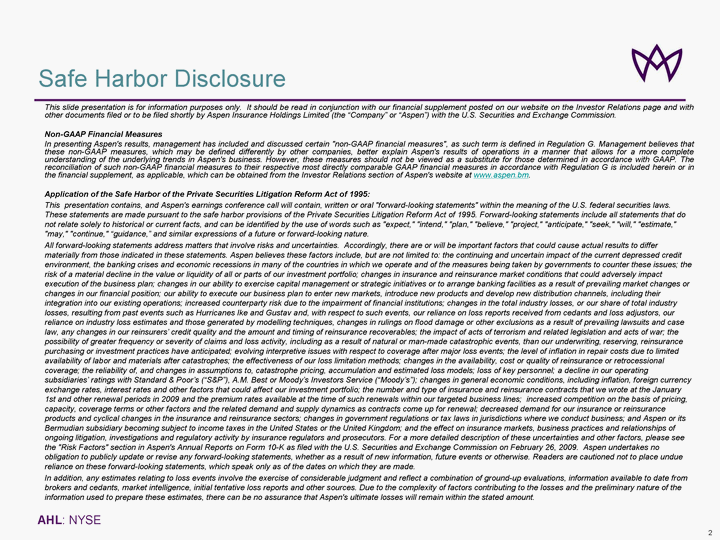
| Safe Harbor Disclosure This slide presentation is for information purposes only. It should be read in conjunction with our financial supplement posted on our website on the Investor Relations page and with other documents filed or to be filed shortly by Aspen Insurance Holdings Limited (the "Company" or "Aspen") with the U.S. Securities and Exchange Commission. Non-GAAP Financial Measures In presenting Aspen's results, management has included and discussed certain "non-GAAP financial measures", as such term is defined in Regulation G. Management believes that these non-GAAP measures, which may be defined differently by other companies, better explain Aspen's results of operations in a manner that allows for a more complete understanding of the underlying trends in Aspen's business. However, these measures should not be viewed as a substitute for those determined in accordance with GAAP. The reconciliation of such non-GAAP financial measures to their respective most directly comparable GAAP financial measures in accordance with Regulation G is included herein or in the financial supplement, as applicable, which can be obtained from the Investor Relations section of Aspen's website at www.aspen.bm. Application of the Safe Harbor of the Private Securities Litigation Reform Act of 1995: This presentation contains, and Aspen's earnings conference call will contain, written or oral "forward-looking statements" within the meaning of the U.S. federal securities laws. These statements are made pursuant to the safe harbor provisions of the Private Securities Litigation Reform Act of 1995. Forward-looking statements include all statements that do not relate solely to historical or current facts, and can be identified by the use of words such as "expect," "intend," "plan," "believe," "project," "anticipate," "seek," "will," "estimate," "may," "continue," "guidance," and similar expressions of a future or forward-looking nature. All forward-looking statements address matters that involve risks and uncertainties. Accordingly, there are or will be important factors that could cause actual results to differ materially from those indicated in these statements. Aspen believes these factors include, but are not limited to: the continuing and uncertain impact of the current depressed credit environment, the banking crises and economic recessions in many of the countries in which we operate and of the measures being taken by governments to counter these issues; the risk of a material decline in the value or liquidity of all or parts of our investment portfolio; changes in insurance and reinsurance market conditions that could adversely impact execution of the business plan; changes in our ability to exercise capital management or strategic initiatives or to arrange banking facilities as a result of prevailing market changes or changes in our financial position; our ability to execute our business plan to enter new markets, introduce new products and develop new distribution channels, including their integration into our existing operations; increased counterparty risk due to the impairment of financial institutions; changes in the total industry losses, or our share of total industry losses, resulting from past events such as Hurricanes Ike and Gustav and, with respect to such events, our reliance on loss reports received from cedants and loss adjustors, our reliance on industry loss estimates and those generated by modeling techniques, changes in rulings on flood damage or other exclusions as a result of prevailing lawsuits and case law, any changes in our reinsurers' credit quality and the amount and timing of reinsurance recoverables; the impact of acts of terrorism and related legislation and acts of war; the possibility of greater frequency or severity of claims and loss activity, including as a result of natural or man-made catastrophic events, than our underwriting, reserving, reinsurance purchasing or investment practices have anticipated; evolving interpretive issues with respect to coverage after major loss events; the level of inflation in repair costs due to limited availability of labor and materials after catastrophes; the effectiveness of our loss limitation methods; changes in the availability, cost or quality of reinsurance or retrocessional coverage; the reliability of, and changes in assumptions to, catastrophe pricing, accumulation and estimated loss models; loss of key personnel; a decline in our operating subsidiaries' ratings with Standard & Poor's ("S&P"), A.M. Best or Moody's Investors Service ("Moody's"); changes in general economic conditions, including inflation, foreign currency exchange rates, interest rates and other factors that could affect our investment portfolio; the number and type of insurance and reinsurance contracts that we wrote at the January 1st and other renewal periods in 2009 and the premium rates available at the time of such renewals within our targeted business lines; increased competition on the basis of pricing, capacity, coverage terms or other factors and the related demand and supply dynamics as contracts come up for renewal; decreased demand for our insurance or reinsurance products and cyclical changes in the insurance and reinsurance sectors; changes in government regulations or tax laws in jurisdictions where we conduct business; and Aspen or its Bermudian subsidiary becoming subject to income taxes in the United States or the United Kingdom.; the effect on insurance markets, business practices and relationships of ongoing litigation, investigations and regulatory activity by insurance regulators and prosecutors. For a more detailed description of these uncertainties and other factors, please see the "Risk Factors" section in Aspen's Annual Reports on Form 10-K as filed with the U.S. Securities and Exchange Commission on February 26, 2009. Aspen undertakes no obligation to publicly update or revise any forward-looking statements, whether as a result of new information, future events or otherwise. Readers are cautioned not to place undue reliance on these forward-looking statements, which speak only as of the dates on which they are made.. In addition, any estimates relating to loss events involve the exercise of considerable judgment and reflect a combination of ground-up evaluations, information available to date from brokers and cedants, market intelligence, initial tentative loss reports and other sources. Due to the complexity of factors contributing to the losses and the preliminary nature of the information used to prepare these estimates, there can be no assurance that Aspen's ultimate losses will remain within the stated amount. 2 |
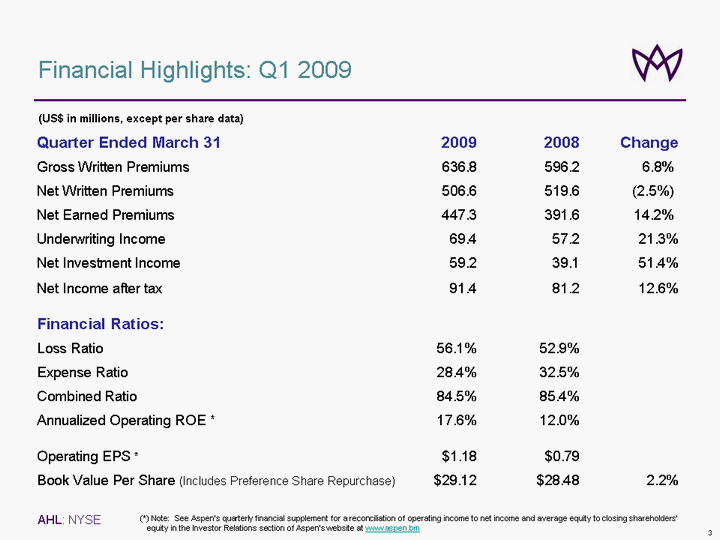
| Financial Highlights: Q1 2009 3 Quarter Ended March 31 2009 2008 Change Gross Written Premiums 636.8 596.2 6.8%) Net Written Premiums 506.6 519.6 (2.5%)) Net Earned Premiums 447.3 391.6 14.2%) Underwriting Income 69.4 57.2 21.3% Net Investment Income 59.2 39.1 51.4% Net Income after tax 91.4 81.2 12.6% Financial Ratios: Loss Ratio 56.1% 52.9% Expense Ratio 28.4% 32.5% Combined Ratio 84.5% 85.4% Annualized Operating ROE * 17.6% 12.0% Operating EPS (Inc Preference Share Repurchase)* $1.56 $0.79 Book Value Per Share (Includes Inc Preference Share Repurchase) $29.12 $28.48 2.2% (US$ in millions, except per share data) (*) Note: See Aspen's quarterly financial supplement for a reconciliation of operating income to net income and average equity to closing shareholders' equity in the Investor Relations section of Aspen's website at www.aspen.bm |
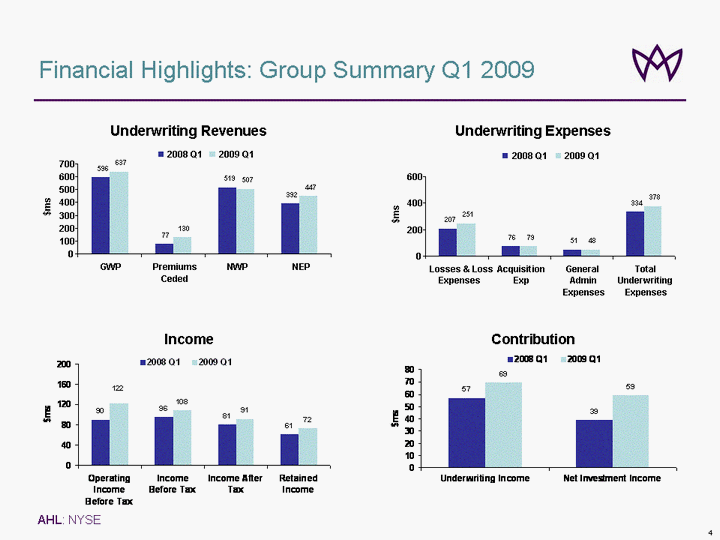
| Financial Highlights: Group Summary Q1 2009 Underwriting Revenues GWP Premiums Ceded NWP NEP 2008 Q1 596.4 76.6 519.0 391.6 2009 Q1 636.8 130.2 506.6 447.3 North 45.9 46.9 45 43.9 Underwriting Expenses Losses & Loss Expenses Acquisition Exp General Admin Expenses Total Underwriting Expenses 2008 Q1 207.2 76.4 50.8 334.4 2009 Q1 250.8 78.6 48.0 377.9 North 45.9 46.9 45 43.9 Income Underwriting Income Net Investment Income 2008 Q1 57.2 39.1 2009 Q1 69.4 59.2 North 45.9 46.9 Contribution Operating Income Before Tax Income Before Tax Income After Tax Retained Income 2008 Q1 90.2 95.5 81.2 61.4 2009 Q1 122 108.3 91.4 72.2 North 45.9 46.9 45 43.9 5 |
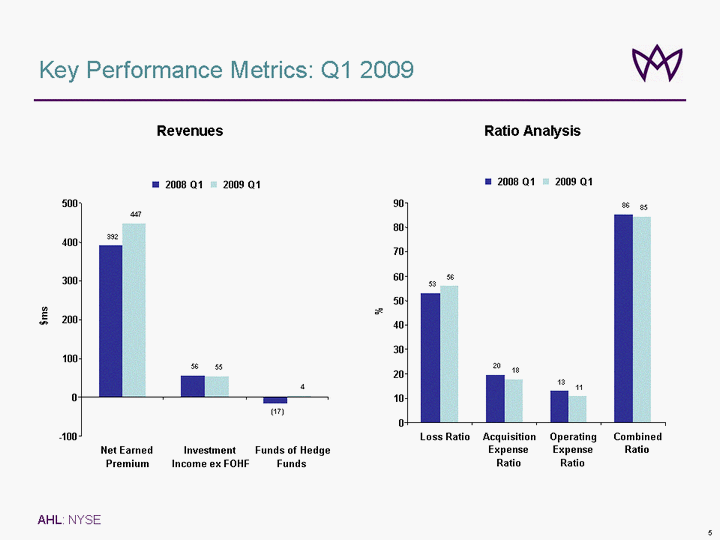
| Key Performance Metrics: Q1 2009 Revenues Net Earned Premium Investment Income ex FOHF Funds of Hedge Funds 2008 Q1 391.6 56 -16.9 2009 Q1 447.3 55.2 4 North 45.9 99 45 Ratio Analysis Loss Ratio Acquisition Expense Ratio Operating Expense Ratio Combined Ratio 2008 Q1 52.9 19.5 13 85.4 2009 Q1 56.1 17.6 10.8 84.5 North 45.9 99 45 5 |
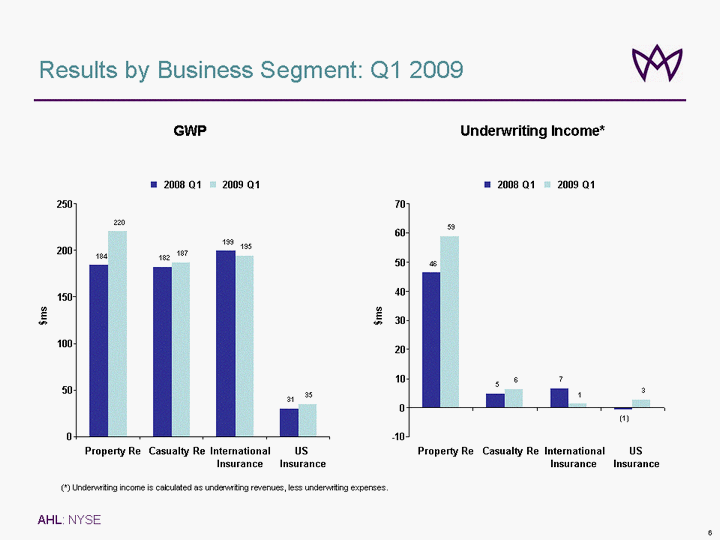
| Results by Business Segment: Q1 2009 GWP Underwriting Income* Property Re Casualty Re International Insurance US Insurance 2008 Q1 184.2 182.1 199.3 30.6 2009 Q1 220.0 186.8 194.7 34.8 North 45.9 99 45 Property Re Casualty Re International Insurance US Insurance 2008 Q1 46.0 4.8 6.6 -0.7 2009 Q1 58.9 6.4 1.4 2.7 North 45.9 99 7 (*) Underwriting income is calculated as underwriting revenues, less underwriting expenses. |
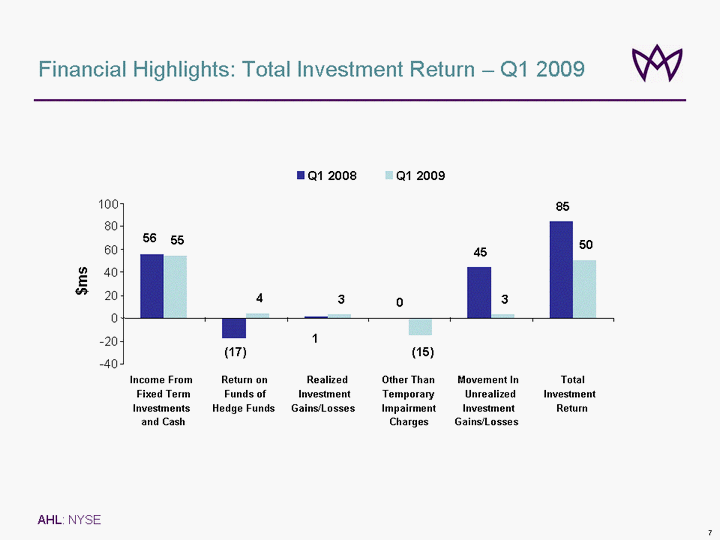
| Financial Highlights: Total Investment Return - Q1 2009 Income From Fixed Term Investments and Cash Return on Funds of Hedge Funds Realized Investment Gains/Losses Other Than Temporary Impairment Charges Movement In Unrealized Investment Gains/Losses Total Investment Return Q1 2008 56 -16.9 1 0 45.0 84.5 Q1 2009 55.2 4 3 -15.2 3.3 50.3 North 45.9 99 45 43.9 8 |
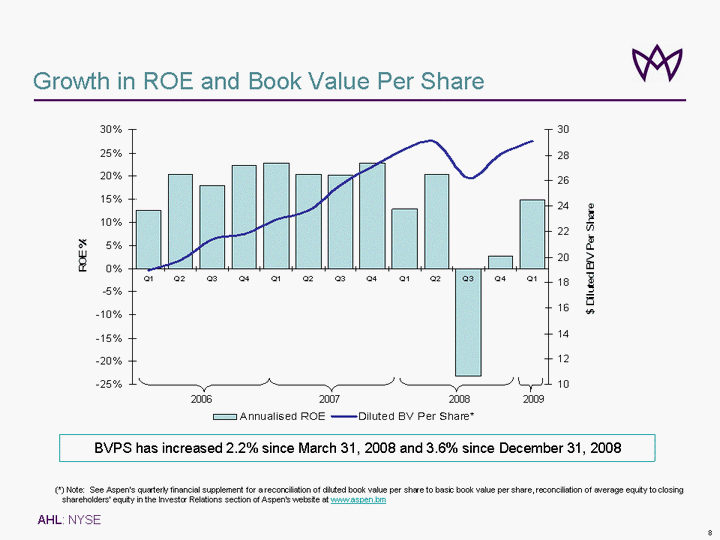
| Growth in ROE and Book Value Per Share Q1 Q2 Q3 Q4 Q1 Q2 Q3 Q4 Q1 Q2 Q3 Q4 Q1 Annualised ROE 0.125 0.204 0.18 0.224 0.229 0.204 0.202 0.228 0.128 0.204 -0.232 0.028 0.148 Diluted BV Per Share* 18.95 19.76 21.41 21.83 22.93 23.63 25.68 27.08 28.48 28.99 26.21 28.1 29.12 BVPS has increased 2.2% since March 31, 2008 and 3.6% since December 31, 2008 9 (*) Note: See Aspen's quarterly financial supplement for a reconciliation of diluted book value per share to basic book value per share, reconciliation of average equity to closing shareholders' equity in the Investor Relations section of Aspen's website at www.aspen.bm 2006 2007 2008 2009 |
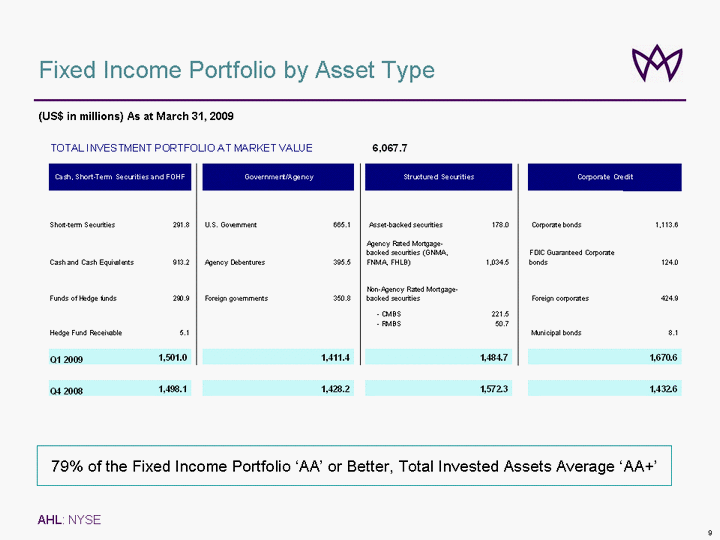
| Fixed Income Portfolio by Asset Type (US$ in millions) As at March 31, 2009 9 79% of the Fixed Income Portfolio 'AA' or Better, Total Invested Assets Average 'AA+' |
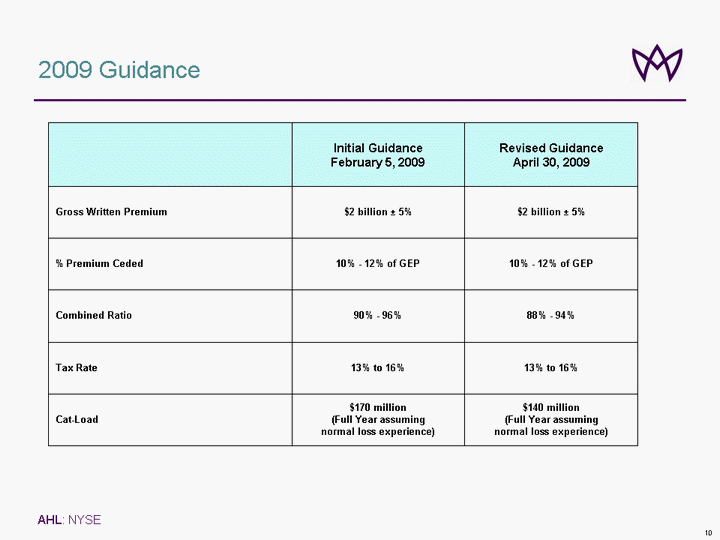
| 2009 Guidance 10 Initial Guidance February 5, 2009 Revised Guidance April 30, 2009 Gross Written Premium $2 billion +- 5% $2 billion +- 5% % Premium Ceded 10% - 12% of GEP 10% - 12% of GEP Combined Ratio 90% - 96% 88% - 94% Tax Rate 13% to 16% 13% to 16% Cat-Load $170 million (Full Year assuming normal loss experience) $140 million (Full Year assuming normal loss experience) |
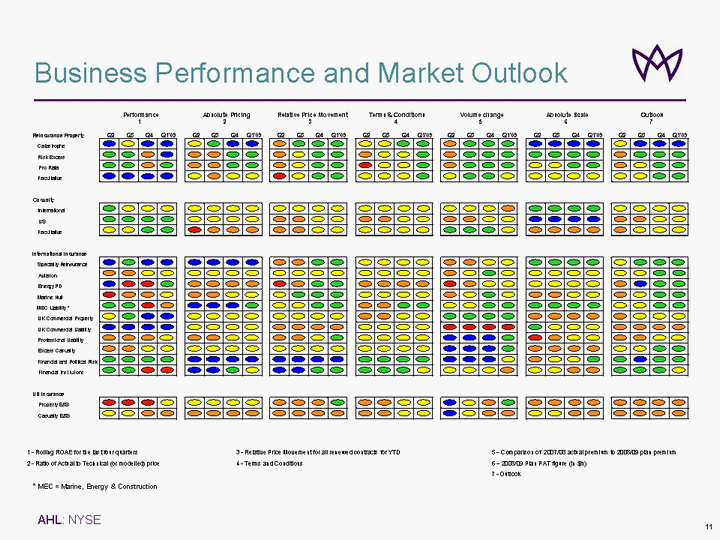
| 11 Business Performance and Market Outlook * MEC = Marine, Energy & Construction ** M&T = Management & Technology 1 - Rolling ROAE for the last four quarters 3 - Relative Price Movement for all renewed contracts for YTD 5 - Comparison of 2007/08 actual premium to 2008/09 plan premium 2 - Ratio of Actual to Technical (or modelled) price 4 - Terms and Conditions 6 - 2008/09 Plan PAT figure (in $m) 7 - Outlook |
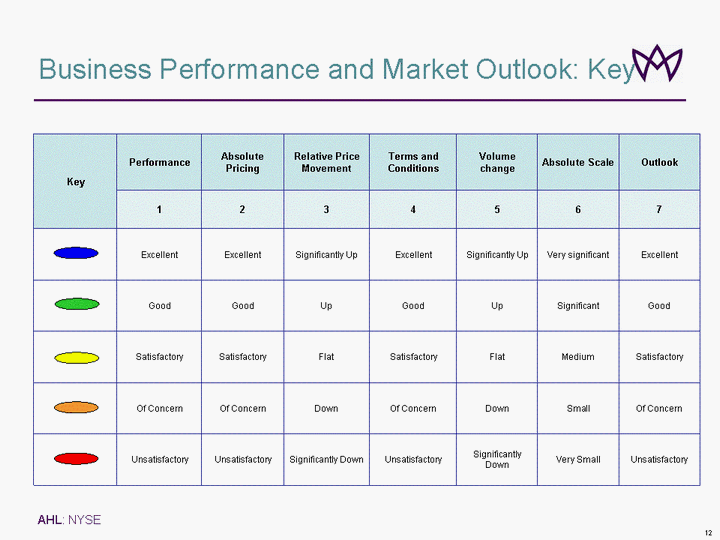
| Business Performance and Market Outlook: Key Key Performance Absolute Pricing Relative Price Movement Terms and Conditions Volume change Absolute Scale Outlook Key 1 2 3 4 5 6 7 Excellent Excellent Significantly Up Excellent Significantly Up Very significant Excellent Good Good Up Good Up Significant Good Satisfactory Satisfactory Flat Satisfactory Flat Medium Satisfactory Of Concern Of Concern Down Of Concern Down Small Of Concern Unsatisfactory Unsatisfactory Significantly Down Unsatisfactory Significantly Down Very Small Unsatisfactory 12 |